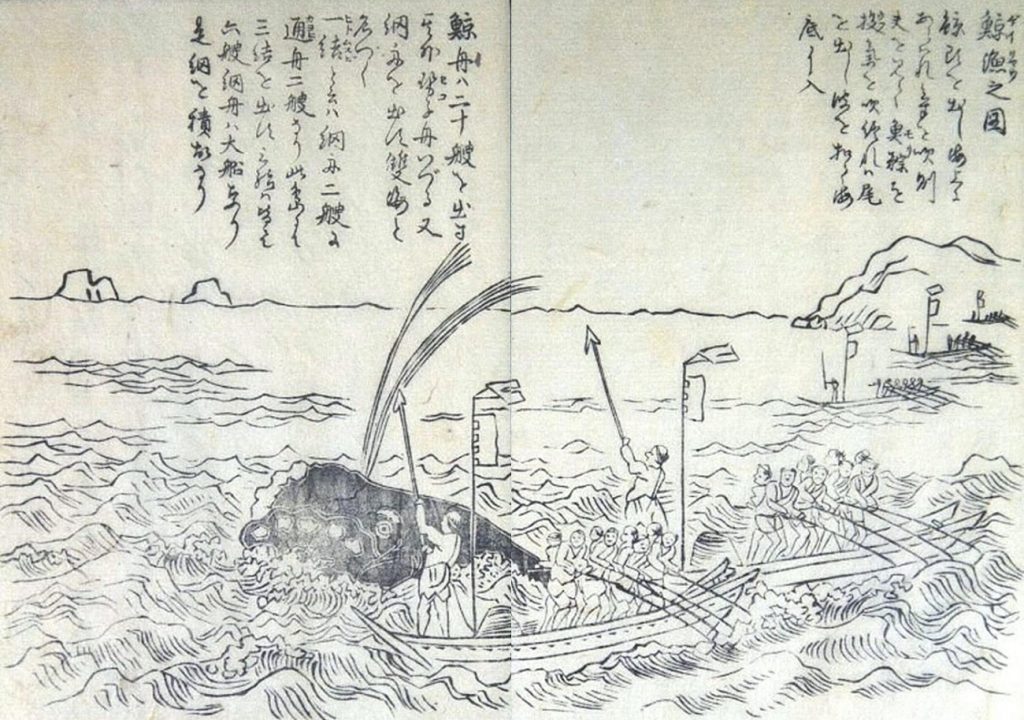This is the first of a two-part series on the history of Japanese whaling.
Part 2: Transition to a Modern Whaling Nation
Shigeo Nakazono is a scholar and author engaged in the research of cultural assets and sociology, and curator of the Ikitsuki Island Museum (Shima no Yakata) in Hirado, Kyushu Prefecture since 1995. His research areas include the history of whaling, religion of Japan’s hidden Christians (kakure kirishitans), history of foreign negotiations, fishing industries, and the performing arts. His major published works include Kujiratorie Monogatari, an explanation of historical drawing of whaling images (co-authored, Genshobo publishing, 2009), Kakure Kurishitan no Kigen, about the rise of the hidden Christians (Genshobo, 2018), and Nihon Hogeishi Gaisetsu, a whaling history (Kokobunsha publishers, 2019). Born in Fukuoka, he is a graduate of Kumamoto University Faculty of Literature (folklore).
Whales have been hunted and utilized in various locations around the world since ancient times. However, there were only two regions where large-scale whaling operations developed with the objective of selling products remotely. One was the western whaling cultural sphere that developed in Europe and North America along the coasts of the North Atlantic. The other was the Japanese whaling cultural sphere, in the western Pacific.
Whaling in Central and Western Japan
In the Japanese region from Honshu and southward, scholars have postulated that hand harpooning using stone spearheads and scrapers for flensing occurred at the end of the early Jomon period (4000 BCE) along the Hirado Strait in northwest Kyushu. Some records have also emerged on the harvest of stranded whales in subsequent eras.
The first clear confirmation that whaling occurred comes during the Muromachi period, at the start of the 15th century, in the Kyushu region of Tsushima. Historical records indicate that whales there were probably hunted using a “net cutoff method,” in which nets are used to seal the mouths of ocean bays and trap the animals inside.

Whaling in the Northern Regions of Japan
In the northern Japanese island of Hokkaido, bone implements with carvings showing whales hunted from boats using spears have been found in the Okhotsk culture that began in the fourth century. Oral interviews have also confirmed that the Ainu hunted whales using poisoned spears during the Meiji period (1868-1912).
Whaling in Hokkaido thus developed separately from that in Honshu and other areas further south in Japan, and the hand harpooning methods used there can be considered to be a part of the whaling practices that developed among ethnic groups in various locations along the North Pacific and Arctic coasts.
Implements and Methods in Traditional Whaling
During the Muromachi period, documents such as the diaries of nobles confirm that whale meat was used as a premium food ingredient in the imperial territories centered around Kyoto. One source of this meat was Cape Moro (in what is now the town of Minamichita in Aichi Prefecture) in Ise Bay, where specialized organizations (whaling groups) began hunting whales using hand harpooning in the Genki period (1570 – 1573).
The hand harpoon method was improved as it was passed down to various fishing grounds, including Awa (at the tip of the Boso Peninsula), Kishu (along the coast of the Kii Peninsula), Tosa (along the coast of present-day Kochi Prefecture), and Saikai (along the coast of the Tsushima Straits between what is now Yamaguchi Prefecture and Nagasaki Prefecture). Such locations actively adopted these improvements, and Japanese traditional whaling was established.
The main characteristic of traditional whaling is that a base is established on land for flensing and processing, while whaling takes place at sea along the coast. A major breakthrough came in year five of the Enpo period (1677), when the net whaling method was developed in the Taiji village of the Kishu region. This method involved first driving whales into large nets laid out at sea, entangling them and hindering their movements, then harpooning them.
This approach included many unique operations that made it distinct from the western hand harpoon method. One difference was the throwing style that launched the harpoons upward in an arc toward the target. Another was the act of swimming out to whales once their movements had been restricted, and cutting holes near their blowholes to string ropes through. The rope was passed to two boats, which attached it to poles laid between them to transport captured whales. This became a principal method of whaling and was adopted in the Tosa and Saikai fishing grounds, continuing until the end of the Meiji period.
Other methods were also employed during the period. The net cutoff method was used in Ine of Kyoto Prefecture, while in Toyama Harbor whales were caught along with tuna and yellowtail. In Saikai, fixed nets designed specifically to capture whales appeared.

How Whales Contributed to Human Life
In traditional whaling, captured whales were processed into whale oil and meat. Whale oil was used for fuel, but also as a pesticide to eliminate planthoppers, which had been a source of famine, providing a boon to farmers’ livelihoods.
Whale meat that had been pickled in salt was a source of protein and fat from winter to the beginning of summer, and many types of whale dishes were consumed in the coastal regions of western Japan and the Sea of Japan. Other parts of the whale, such as the sinews, baleen and bones, were used for products such as bowstrings, coiled springs, and fertilizer.
Whales Featured in Cultural Practices
Cultural aspects of traditional whaling include the whale songs the whalers sang as they completed their tasks, and memorial ceremonies held for the souls of dead whales. There were dedicated whale graves and Buddhist ancestral tablets. Modern events such as the Nagasaki “kunchi” festival and the Yokkaichi whale boat ceremonies include activities like parades with whale floats and whaling reenactments.
Japanese traditional whaling encompasses a diverse and original range of practices. It has been successfully carried out for centuries, led to cultural developments such as whale songs and festivals in the Japanese archipelago, and provided resources for a large population that had only limited interactions with the outside world.
As an enterprise that deepened awareness of people and whales as shared inhabitants of the natural world, it also has significance globally as a source of industrial and cultural heritage.

